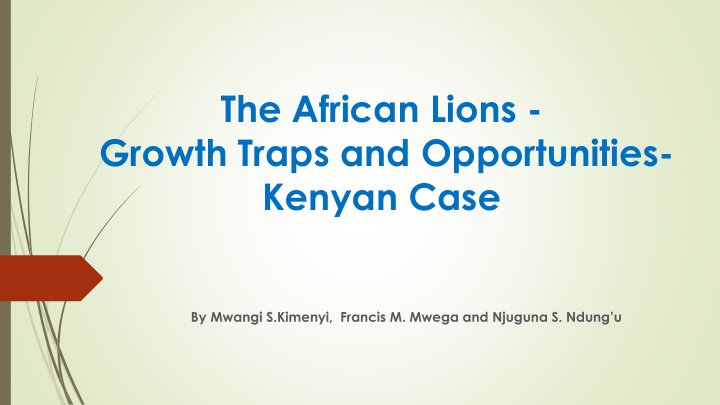



The African Lions - Growth Traps and Opportunities- Kenyan Case By Mwangi S.Kimenyi, Francis M. Mwega and Njuguna S. Ndung’u
Six African Countries - The African Lions The Distinguishing features: 1. Improved macro economic policy environment 2. High commodity prices 3. Improving governance 4. Digital technology 5. Demographic transition 6. Expanding cities 7. Better targeted social protection
Introduction: The Preamble Why is Kenya in the sample of African Lions? 1. Potential to use locational advantage and policy space to spur high economic growth via trade 2. It is a supplier of FDI in the EAC region, 3. The potential for natural resource discoveries 4. The Recurring theme is population structure leading to demographic transition to help countries reap the demographic dividend The effect on the labour market – employment growth – labour productivity – earnings function ▪ and its drivers to drive economic growth. Supporting sectoral policies in agriculture, the financial sector and public investments ▪ In addition support policies like social protection, governance institutions and markets ▪ 5. Just like the countries in the sample, the period 2000-2015 has been marked by huge investments in macro stability, strength institutions, growing political accountability, but more importantly there are opportunities and challenges to overcome – to become an African Lion!
Conclusions and the Road Ahead The country’s future growth faces risks, but also has many important opportunities to spur economic vibrancy and growth. Kenya needs to raise its productivity levels and to raise the savings and investments rates to support ▪ and sustain this future growth profile. The Vision 2030 has put some targets that are slowly taking shape. Kenya should take advantage of its locational advantage to become a regional financial hub, a transit airport city to serve the region, efficient port facilities for the region and an efficient road and railway network system to lower transactions costs for domestic production and regional trade. Youth unemployment remains very high and a likely source of socio-political instability. The analyses of Kenya’s population trends reveal a relatively high rate of population growth and urbanization continues to increase, but majority of the population are rural based. The demographic transition experienced over the years in the country has put Kenya on the path to reaping demographic dividend. If measures are put in place to enhance institutional quality and provide productive employment ▪ opportunities to the large working population, Kenya is likely to realize her demographic dividend even before 2050 target.
Conclusions and the Road Ahead… The emergence of the middle class in the country is also increasingly appealing and presents an opportunity economic and social – political growth through advancement of social progress, realization of inclusive growth, innovation and entrepreneurial drive. The wage differentials between the public and private sector indicate that there are barriers to mobility of labour between the sectors and that the Kenyan labour market is not efficient in allocation of labour. The rising productivity since 2009 and the results for returns on human capital indicate an ▪ improvement in the efficiency of labour in the country. In view of the insufficient capital accumulation in the country, labour tends to move into the informal sector and self-employment, which requires limited capital as opposed to the capital intensive modern sector and capital intensive agricultural activities. Hopefully this will change with the success of financial inclusion taking place in Kenya ▪ To enhance long-term growth prospects, the rapid growth in labour supply should be accompanied with rapid growth in capital accumulation - The key to growth in formal sector employment is capital deepening. Labour market growth and dominance of informal employment has reduced the capacity of the economy to deliver quality employment and output
Conclusions and the Road Ahead.. Kenya has some successes in financial inclusion and in the last ten years or so and the financial sector growth has pulled the overall growth with it - Financial inclusion is a market access policy that recognizes that the poor are willing to save and invest but are sensitive to the type of financial products, their costs, and their delivery mechanisms. Other markets should follow the banking sector access example – inaccessibility of markets is one factor that sustains poverty.
The Economic Performance… GDP Growth Rate and Gross Capital Formation/ GDP Ratio: 1964-2014 35 30 25 20 15 10 5 0 -5 65 70 75 80 85 90 95 00 05 10 GROWTH GCFGDP
Kenya’s Population Size, Growth and Structure… Prospects of Earning Demographic Dividend Life Expectancy, Other Rates and Percentages 60 1400 50 GDP per capita (Current US$) 1200 40 1000 30 800 20 600 10 400 0 200 -10 0 -20 1960 1963 1966 1969 1972 1975 1978 1981 1984 1987 1990 1993 1996 1999 2002 2005 2008 2011 2012 2013 GDP per capita (current US$) Share of working age Population (% of Total) Change in Support ratio (% of working age population) Fertility rate, Total (Births per woman) Mortality rate, crude (per 1,000 people) Life expectancy at birth, Total (years)
V. The Labour Market: Trends, Structure, Growth- Employment Nexus… The main findings of the labour market structure, the unemployment problem and the youth; the evidence on employment-growth-poverty reduction in Kenya 35 12 10 30 8 25 6 Employment Elasticity 20 Growth (%) 4 15 2 10 0 5 -2 0 -4 1985 1986 1987 1988 1989 1990 1991 1992 1993 1994 1995 1996 1997 1998 1999 2000 2001 2002 2003 2004 2005 2006 2007 2008 2009 2010 2011 2012 2013 2014 -5 -6 Year GDP growth (annual %) Total Employment Growth (%) Employment Elasticity
Recommend
More recommend